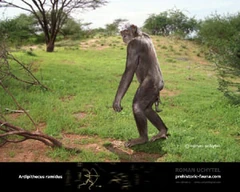| Ardipithecus | |
|---|---|

| |
| An artist's illustration of Ardipithecus ramidus | |
| Scientific classification | |
| Kingdom: | Animalia |
| Phylum: | Chordata |
| Class: | Mammalia |
| Order: | Primates |
| Family: | Hominidae |
| Subfamily: | Homininae |
| Tribe: | (debated Hominini) |
| Genus: | †Ardipithecus |
| Referred species | |
| |
Ardipithecus is a very early hominin genus. Two species are described in the literature: A. ramidus, which lived about 4.4 million years ago during the early Pliocene, and A. kadabba, dated to approximately 5.6 million years ago (late Miocene).
Ardipithecus ramidus[]
Ardipithecus was an ancient hominid genus, known from the early Pliocene (about 5.8-4.4 million years ago). Since the genus Ardipithecus has much in common with modern African apes, some authors considered it likely an ancestor of chimpanzees rather than humans. However, most consider this animal the oldest human ancestor because of the similarity of the teeth with those of Australopithecus. In addition, there are additional foot bones which was the small cannon bone (peroneum), which is present in the human foot, but is absent in the feet of modern apes. Sometimes referred to as an early Australopithecus, as their skull is intermediate between the two, judging by the size of bones, in size Ardipithecus were comparable to those of chimpanzees. Ardipithecus lived in the tropical forests and woodlands and may have been able to stand in an upright posture, but were able to climb trees; its diet was mostly fruit and nuts. Fragments of an Ardipithecus ramidus skeleton was discovered in the 1990's in September 1994. Their age was determined from above and below the overlying volcanic rocks as 4.4 million years ago. Species-possessor researchers found a skeleton nicknamed "Hardy", which in Afar language means "land".
Ardipithecus kadabba[]
Ardipithecus kadabba is "known only from teeth and bits and pieces of skeletal bones", and is dated to aproximately 5.6 million years ago. It has been described as a "probable chronospecies" (i.e. ancestor) of A. ramidus. Although originally considered a subspecies of A. ramidus, in 2004 anthropologists Yohannes Haile-Selassie, Gen Suwa and Tim D. White published an article elevating A. kadabba to species level on the basis of newly-discovered teeth from Ethiopia. These teeth show "primitive morphology and wear pattern" which demonstrate that A. kadabba is a distinct species from A. ramidus.
The specific name comes from the Afar word for "basal family ancestor".